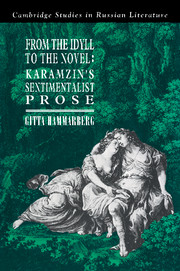Book contents
- Front Matter
- Contents
- Preface and acknowledgments
- Notes on the text
- 1 The literary and intellectual context
- 2 Theory of Sentimentalism
- 3 The literary model: the idyll
- 4 The extra-literary model: salon trifles
- 5 Serious Sentimental tales: narrator as narratee
- 6 Humorous Sentimental tales: narrator as parodist
- Notes
- Bibliography
- Index
5 - Serious Sentimental tales: narrator as narratee
Published online by Cambridge University Press: 22 September 2009
- Front Matter
- Contents
- Preface and acknowledgments
- Notes on the text
- 1 The literary and intellectual context
- 2 Theory of Sentimentalism
- 3 The literary model: the idyll
- 4 The extra-literary model: salon trifles
- 5 Serious Sentimental tales: narrator as narratee
- 6 Humorous Sentimental tales: narrator as parodist
- Notes
- Bibliography
- Index
Summary
The literary potentials of the idyll and the trifle as I have described them, were to find their fullest and most creative realization in the most developed form of Sentimentalist prose fiction: the Sentimental tale. As we have already seen, the idyll and the trifle were by no means mutually exclusive concepts, but shared the basic Sentimental chronotope of solipsistic intimacy, pleasure, and sympathy. There was a great deal of interaction between idylls and trifles. This ageneric trend continues with the Sentimental tale and the label is used here mostly as a heuristic device to facilitate our discussion. Nevertheless, I believe one can make a qualitative distinction between humorous and serious Sentimental tales. Within the latter, what I shall call the ‘complete fragment’ most directly develops properties inherent in the idyll, and the ‘incomplete fragment’ can be seen as a development of certain trifle potentials to their limits. I should stress, however, that these divisions are not meant to reflect genres as perceived at the time.
On the most general structural level, a Sentimental tale shall be viewed as a trivocal (or sometimes bivocal) utterance. It is the account of a narrator's present personal re-experience of a past personal experience as narratee of an earlier (thus twice removed) vicarious love intrigue. The core love story is doubly framed by two sets of narrators/narratees, a primary (present) and secondary (past) narrator/narratee. Thus the easy switches in roles we have noted between narrator and narratee are especially highlighted in Sentimental tales.
- Type
- Chapter
- Information
- From the Idyll to the NovelKaramzin's Sentimentalist Prose, pp. 128 - 202Publisher: Cambridge University PressPrint publication year: 1991



